The world of energy is changing. We are moving away from centralised power generation and towards a more distributed system that increasingly relies on renewable energy sources. This shift is giving rise to Local Energy Communities (LECs) — groups of energy consumers, producers, and prosumers who collaborate to meet their energy needs locally. These communities offer unique benefits, such as greater sustainability and cost-effectiveness. However, this transformation presents new challenges for grid companies, who must now find innovative ways to integrate these decentralised energy resources into the existing infrastructure while ensuring that the grid remains reliable and affordable.
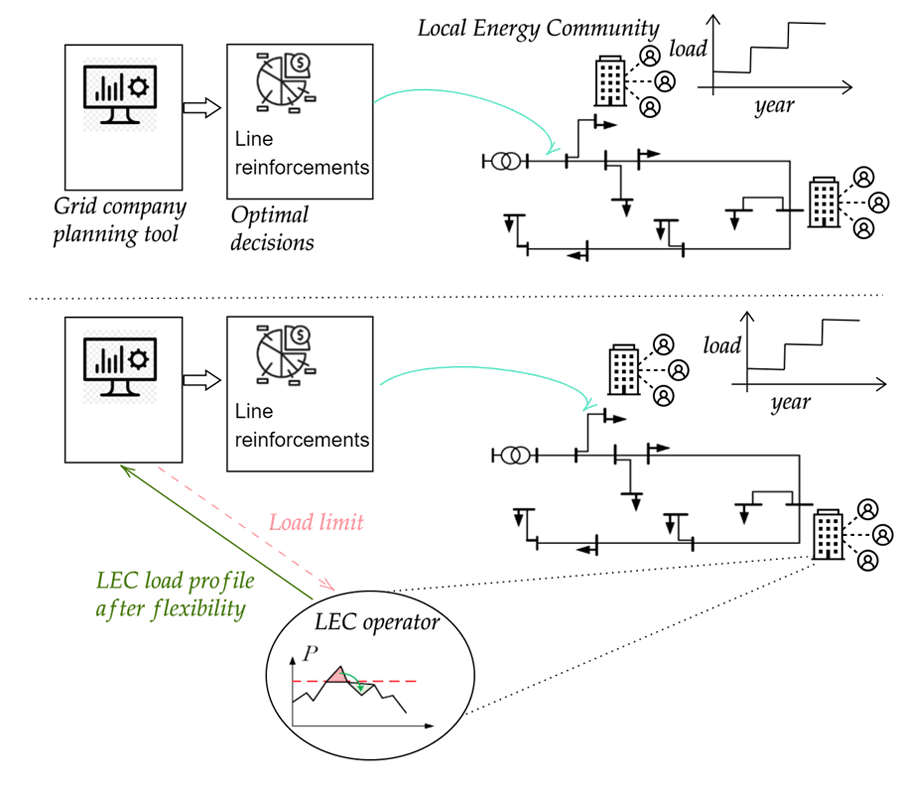
In our recent research paper, “Economic Assessment of Integrating Fast-Charging Stations and Energy Communities in Grid Planning“, we tackle a significant gap in the energy sector—bridging academic research and real-world grid planning. While existing academic methodologies often rely on complex optimisation models that are impractical for most grid companies, our work presents a more accessible alternative. Designed with grid companies in mind, our new method simplifies these complex models without sacrificing effectiveness. The aim is to make the transition to smart grid planning more attainable for industry professionals.
Why integrating local energy communities matters to grid companies
The limitations of traditional grid planning
One of the tasks of grid planners is to decide which measures to put in place to prepare the grid to supply new energy consumption, and when and where to implement these measures. Traditionally, the only measures to consider have been investments in physical grid infrastructure, or passive measures. However, traditional grid planning methods are not able to fully handle the complexities of active measures, such as flexibility resources. These resources can provide a variety of benefits to the grid, such as reducing peak demand and improving voltage regulation.
Read more:
Active measures: The next step
While active measures bring new layers of complexity to the planning process—often requiring advanced models and algorithms to optimise their use—our methodology offers a solution to this challenge. It builds upon the traditional grid planning framework familiar to the grid companies but extends it to integrate active measures such as flexibility from LECs, in addition to the passive measures. The methodology is designed to be modular and compatible with existing planning tools. This means that grid companies can improve their planning practices without overhauling them completely, but by taking incremental steps.
Key features of our methodology
Cost-efficiency
Our methodology incorporates a specialised model designed to ensure acceptable voltage levels across the distribution grid. What sets this model apart is its dual focus: it not only identifies which distribution lines are most likely to need upgrades to maintain acceptable voltage levels, but it also considers the associated costs. By doing so, the model can selectively recommend the least expensive lines for upgrade while still meeting voltage limits. This results in more cost-effective grid investments, helping you save money in the long term.
Economic assessment for strategic planning
Our methodology integrates a model for economic evaluation of different grid planning strategies. By contrasting the financial implications of traditional grid planning against active grid management incorporating LECs, grid companies can strategically decide the degree to which active measures should be part of their grid planning process.
Real-world application: A case study on a Norwegian distribution network
To further demonstrate the use of our methodology, we carried out simulation studies on a Norwegian distribution network. These studies provide concrete examples of how our methodology can be applied in real-world scenarios.
Read more:
Cost: passive vs active grid planning
We analysed the financial implications of grid planning decisions, which can be divided into two main categories: investment costs and operational costs. Our study illustrates an important trade-off: if a grid company opts for higher utilization of LEC flexibility, the up-front investment costs for grid reinforcement can be considerably reduced, and investments can be postponed. However, this reduction in investment costs comes at the expense of increased operational costs. Grid companies can use this information to make better choices for long-term planning and saving money.
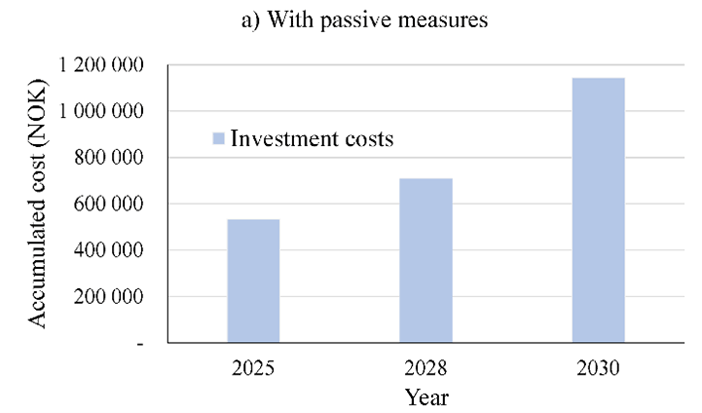
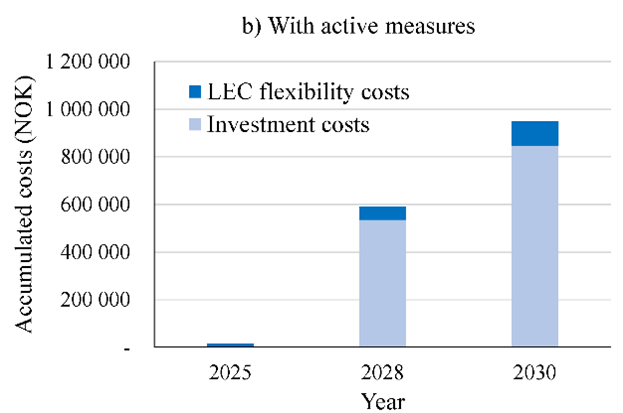
B – Striking the balance: Optimal utilisation of flexibility
The study found that the lowest total cost is achieved by a relatively modest utilisation of demand flexibility. If demand flexibility is utilised too intensively, the cost saving from reduced grid investments is soon offset by additional operational costs and consumer inconvenience. However, we believe that the cost saving potential of active measures, such as LEC flexibility, can be higher than the conservative estimate found in our study. The operational benefits will significantly increase if the grid company implements a smarter, more differentiated, and dynamic flexibility activation strategy.
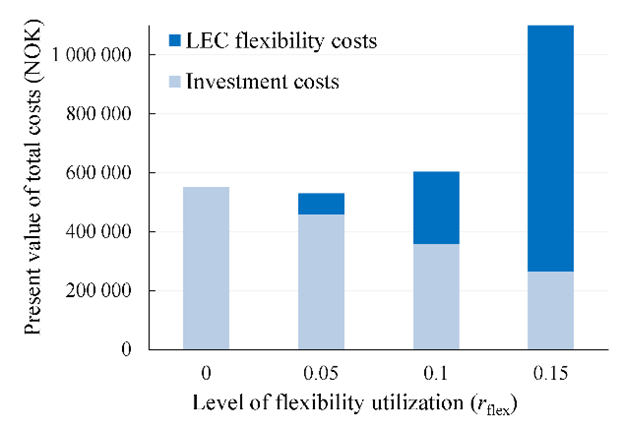
C – Navigating uncertainty: How to deal with the unknown
The optimal degree of utilisation of LEC flexibility depends on a number of factors, including the number of days per year that flexibility needs to be activated. For example, our study found that if a significant amount of peak shaving is needed for more than around 45 days per year, planning with only passive measures will give the lowest total costs. However, if the number of days per year with peak shaving is lower, then integrating LEC flexibility into the grid planning can lead to significant savings.
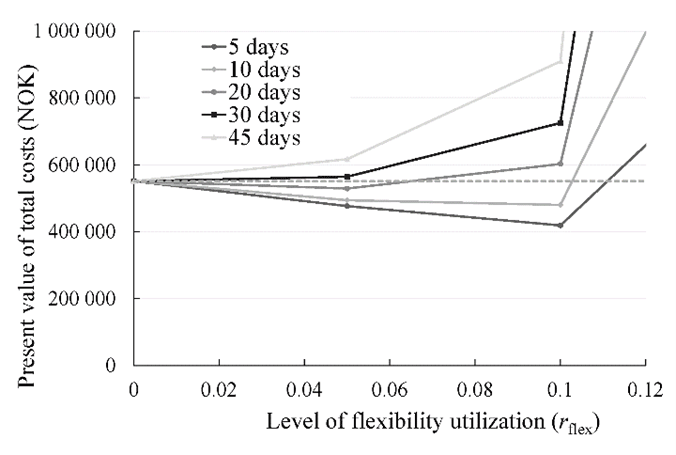
The business perspective: A new approach to pricing flexibility
Our research suggests that our methodology could lead to new pricing models for flexibility in the distribution system. This could benefit both grid companies and LECs as it would allow them to better manage their resources and optimise their operations. The value of flexibility is uncertain, but our study introduces a new way to figure out how much it is worth. We do this by looking at what it would cost to upgrade the grid infrastructure instead. This gives all parties a starting point for negotiating prices and opens the door for more cost-effective solutions in the energy sector.
Final thoughts: Navigating the energy transition
The world of energy is changing, and our approaches to grid planning methods need to be updated accordingly. By integrating active measures, such as demand flexibility provided by LECs, into our grid planning framework, we can defer substantial grid investments and reduce socio-economic costs. However, achieving the optimal balance of flexibility utilisation requires considerable understanding of various case-dependent parameters and the operational costs associated with flexibility activation. This research is a step towards a more sustainable and efficient energy future.









Comments
No comments yet. Be the first to comment!